Types of Sewing Machine
The machine with which fabric or garments are sewn, that machine is called the sewing machine. With a sewing machine, in addition to fabrics, the other material, such as, leather, sac, bag, tent etc, are also sewn. Sewing machine is mainly of two types, such as,
- Manually operated sewing machine
- Electrically operated sewing machine
A. Manually operated sewing machine:
This type of machines are operated mainly by applying physical power. Moving the machine pulley by hand or by leg, the sewing works are done, resulting very low production and high labour in running these machines. Manually operated sewing machines are mainly used in houses and in tailoring shops.
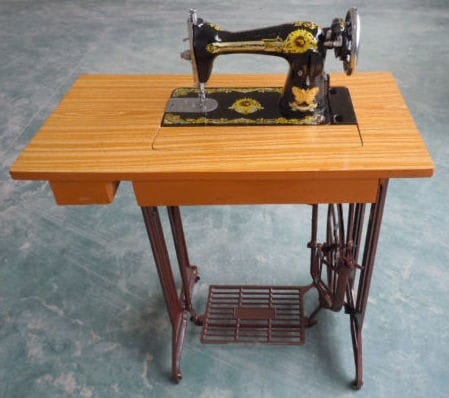
B. Electrically operated sewing machine:
This type of sewing machine is mainly operated by electrical power. The production capacity of these sewing machines are relatively much higher for which they are being used on a large scale in the garments industries. The sewing machines which are used in garments factories are called industrial sewing machine.
Different Types of Industrial Sewing Machines
There are many types of industrial sewing machines, such as:
- Lock stitch machine
- Chain stitch machine
- Over edge/over lock machine
- Zig-zag stitching machine
- Flat lock machine
- Blind stitch machine
- Button holing machine
- Button attaching machine
- Bar tack machine
- Label sewer
In industrial sewing machine, there may have 1 to 4 needles. Various companies are making these industrial machines, such as, Puff, Pegasus, Singer, Juki, Brother, Seruba etc. Different types of machines have different types of price, speed, efficiency and performance. But in most of the garments industries in Bangladesh, the machines of Juki company are being used.
There are arrangement of programming in a large number of industrial sewing machines, with which sewing of specific lengths and at specific distances from the end can automatically be done. This type of machines are not regularly available in our country but these machines are being used in most of the industries in industrially developed countries. The production capacity of the programmable machines are very high and the quality of production is also very good, but the price of the machines are relatively very high.
Plain machine is meant to the single needle lock stitch sewing machine. Mentionable here that various types of machines of various companies may not be seen same to look at.
Any type of industrial sewing machines are to be maintained with regular maintenance. The rules of maintenance may vary based on the machines and their companies. For the operation and maintenance of the sewing machines of any company, below listed issues have to be considered with due care:
- Need to clean the machine daily.
- Need to oiling the oiling points of the machine regularly.
- Need to set the needle properly.
- Need to threading the needle thread, bobbin thread, or looper thread properly and to adjust the thread tension.
- Need to adjust the pressure of the presser foot.
- Need to adjust the stitch density.
- Need to on-off of the switches properly.
- Need to handling the machine as per rules.
- Need to rotate the hand wheel towards the operator always.
- After lifting the needle to its highest position and then lifting the pressure foot, then the fabric has to be removed from the machine.
- Need to threading the bobbin in well proportion and in well tension.
- Need to winding the thread in bobbin keeping blank of its 1/5th portion.
About the sewing machines which are being used in garments industries for sewing of garments are discussed below:
1. Lock stitch sewing machine:
The industrial lockstitch sewing machine is generally one needle machine but two needle machine is also used. Various types of feed mechanisms are found with lockstitch sewing machine. The sewing speed of various types of lockstitch and of various companies are different. The sewing speed means making of stitches per minute that means SPM (stitches per minute). The speed of lockstitch machine is generally seen from 1500 to 5500 SPM. Stitch density means the stitches per unit of length, that means the number of stitches in each unit of length. Stitch density may be different based on the machine and company. In Juki, Model-DDL-5500, the highest up to 5mm long stitch can be made. With some lockstitch machines, there are also arrangements of cutting of sewing thread of the machine by automatic thread trimming and automatic bobbin winding. In some lockstitch machines, there is also arrangement for edge trimming of the fabrics before sewing. In case of making the garments with woven fabrics, the use of lockstitch machine is highest.
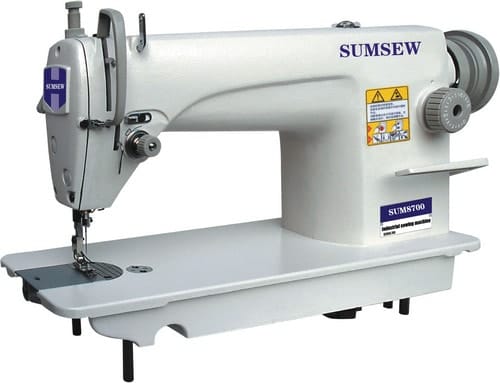
2. Chain stitch sewing machine:
There are various types of sewing machine for making of chain stitches with one or more than one threads. In this type of sewing machines, there may have one or more than one needles. With some machines, there is automatic thread trimmer also. There are adjustments of various types of feed mechanism with the chain stitch machine. The SPM of this type of machine may be from 1800 to 6000. Generally the stitch can be made from 1.4 to 4.5 mm. Chain stitch machines are the most used for sewing of knitted and denim fabrics.
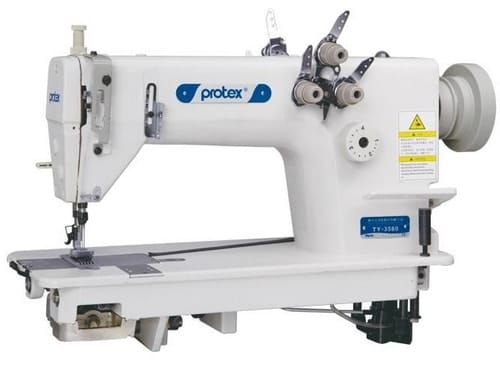
3. Overlock machine:
Mainly the over edge machine is called the overlock machine. In this type of machine, there are one or two needles and automatic edge trimming knife at the front of the needle. For making of overlock stitches, two or five threads are used. The SPM of overlock machine is generally 6500 but overlock machine of 8500 SPM is also found. In this type of machines, during feeding of fabrics, also there are arrangements for stretching (stretching: Max 1:0.6) and gathering (Gathering: Max 1:4). The stitch length can be made highest up to 4 mm and the stitch length can also be changed by push button. Knitted fabric and woven fabrics, this means for the sewing of both the fabrics this type of machine are used. But in the knitted garments factory, the large number of overlock machines are required.
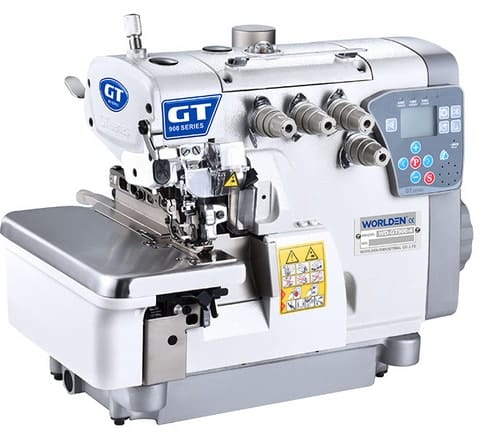
4. Zig-Zag stitching machine:
Zig-zag stitching machine is one of the special editions of the original lockstitch sewing machine. In this type of machine, generally there is one needle and stitches are made by two threads. The needle throw or the width of the hole of a zig-zag stitch can be made from 5 to 10 mm and the stitch length can normally be made from 2 to 2.5 mm. the highest speed of this type of machine is seen up to 5500 SPM. This type of machine is used generally for edge stitching but sometimes it is also used for decorative top stitching. Without this, this machine is used attaching of elastic, tape and braid.
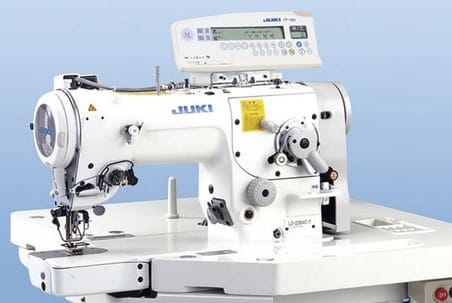
5. Flat lock machine:
In this type of machine, the use of up to 4 needles are seen and the stitches are made by using 4 to 9 threads. The maximum quantity of threads are required for sewing in flat lock machines. For example, about, about 32 inches of thread is required for sewing of 1 inch of length in flat lock. In this type of machine, generally the SPM is 6000 and 8 to 16 stitches can be made in each inch. This is a costly machine and it is used mainly for sewing of knitted fabrics, but this machine is also used in sewing of garments of woven fabrics.
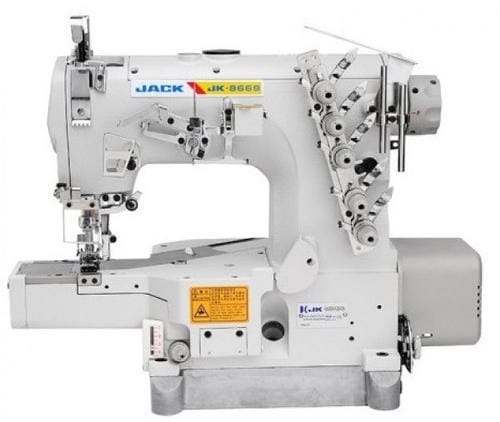
6. Blind stitch machine:
If fabric is sewn with this type of machine, then the sewing is not visible from the front side of the fabric or garment, for which it is called blind stitch machine. Generally curved needles are used in this type of machine, so that needle can partially penetrate into the fabric. The side of the fabric from which the needle penetrates into the fabric, it again return back to the same side, as a result, the sewing is not visible from the front side. In most of the blind stitch machines, also there are “optional skip stitch device” attached, by which the outside layer of fabric can be made partially penetrated in every one stitch or two stitches alternately.
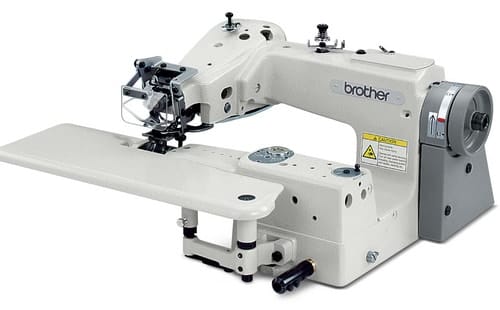
The speed of this type of machine may be up to 2500 SPM and the length of the stitch can be made from 3 to 8 mm. generally one thread is required for making stitch, but blind stitch can also be made in combination of two threads. In case of two thread blind stitch; there is no fear of easily opening of the sewing. It is mainly used in hemming and attaching of facing on a large scale.
7. Button hole machine:
There are a number of machines for making button holes in garments with the help of machines. In button hole machines there are arrangements for making the holes bigger or smaller and also for increasing or decreasing of the density of stitches. Generally lockstitch or chain is used in button hole machines.
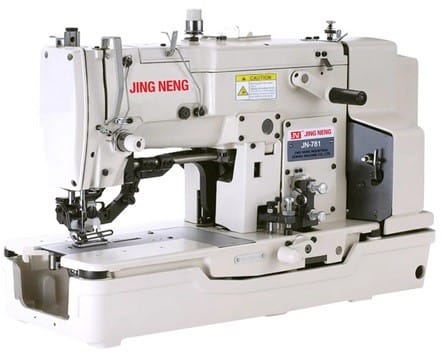
During the period of button holing, button holes are made by cutting of the fabrics before or after the sewing. There are advantages and disadvantages both in cutting of the hole before or after the sewing of the button hole. If the hole is cut before the sewing of the hole, then the cutting part is covered in sewing and it looks beautiful and clean. But the disadvantages is this that if once the sewing cycle starts, there is no more opportunity for changing the places of button holes and without it, due to the reason of flagging, the cutting end creates some problems in making stitches fairly. The advantage of cutting of button hole after sewing the button hole is that due to the reason of defects, the place of button hole, can be changed later on, and during the time of button hole sewing no problem occurs due to flagging. But the biggest problem is that fabric threads are visible along the sewing of the button hole which looks ugly. Generally in case of densely woven and coarse fabrics, button hole is cut before the sewing of the button hole and in case of fine fabrics, button hole is cut after the sewing of the button hole. But for any specific garments, which system will be good that will depend on the nature of that garment.
You may also like: Stitch Formation Techniques of Various Sewing Machines
During making of the button hole, sometimes a strong coarse thread is used along the end of the sewing hole, which is called the gimp. If gimp is used in button hole, the shape of the button hole looks very beautiful and the sewing thread of the button hole stays to some extent raised, as a result, it seems to have pearl shape.
For sewing of button hole, button hole machine with chain stitch or lockstitch can be used. Generally, the button hole machine works un cyclic order, that means if the switch is pressed, after sewing of a complete hole, the machine stops. If it is fully automatic button holing machine, then it completes the sewing of more than one that means predetermined number of holes at predetermined distance. In this process, no marking or sign are required on the fabric for the place of button hole.
8. Button sew / attaching machine:
There are various types of machines for button sewing and in each machine various types of button clamps are required for attaching buttons of various sizes. Specially there are two or four holes in buttons. Again, the four holes button may be attached either by parallel stitching or cross stitching.
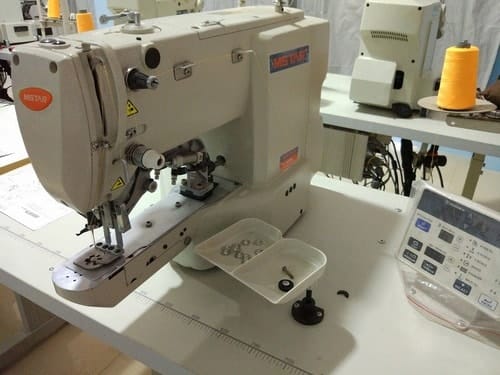
Buttons may be of various types, specially there may be shank under the button or during sewing shank may be made by thread. For sewing of button, lockstitch, chain stitch or hand stitch may be used. If chain stitch is used, sewing is seen clean to look at in the fabric at the back side of the button but the security of the stitch is relatively low, that means button may fall down any time by opening of the sewing. If lockstitch is used, there is no possibility of opening of button that means there is no risk of fall down of buttons, the sewing place at the back side of the button does not look clean.
You may also like: Various Parts of a Sewing Needle with Functions
There is fully automatic machine for attaching the buttons by sewing. In automatic machine, with the help of a hoper and a pipe, buttons are fed in the clamps of the button automatically and button positioning is done. Moreover, in garments predetermined numbers of buttons are attached at predetermined places in cyclic order.
9. Bar tack machine:
It is a cyclic machine for doing strong sewing in a very short length. At first, after tack stitching of small length (1-2 cm), it does cover stitch (zig-zag) on the tack stitch from the opposite direction. The number of tack stitch and cover stitch can be changed a little. This type of machine is generally used for making belt loop, for increasing strength at the pocket corners, and for closing the two corners of the button hole, but it cannot be used for ordinary sewing.
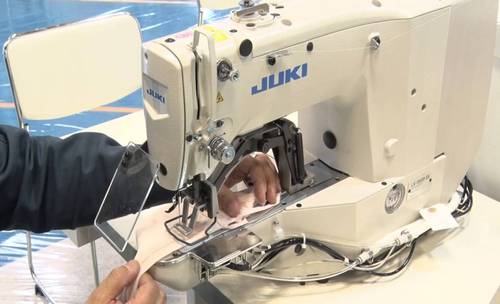
10. Label sewer:
There are various type of machines for attaching of labels of various sizes by sewing in garments. The lock stitches or the chain stitches can be made both straight or zig-zag shapes. Label sewing machine may be both ordinary or fully automatic. In fully automatic machines, labels can be attached accurately and also production rates are high.
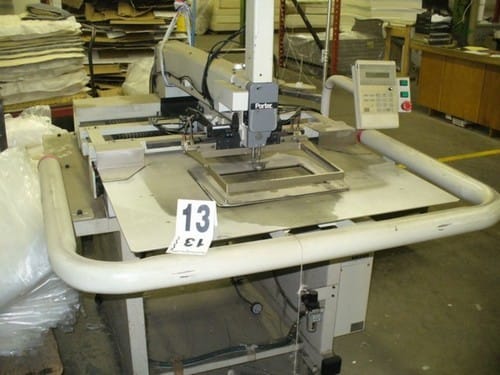
Special sewing machine:
In addition to the above mentioned sewing machines, a good variety of highly improved sewing machines have been made by which the specific works can be done with very high quality. The main objective of developing of such machines is to entrust the quality of works on machines by reducing the dependability on the efficiency of the operators. The responsibility of the operator is to feed the material in the machine, and the responsibility of the machine is to complete the works with wanted quality. Presently, the demand of this types of machines are increasing in the garments manufacturing factories day by day.
